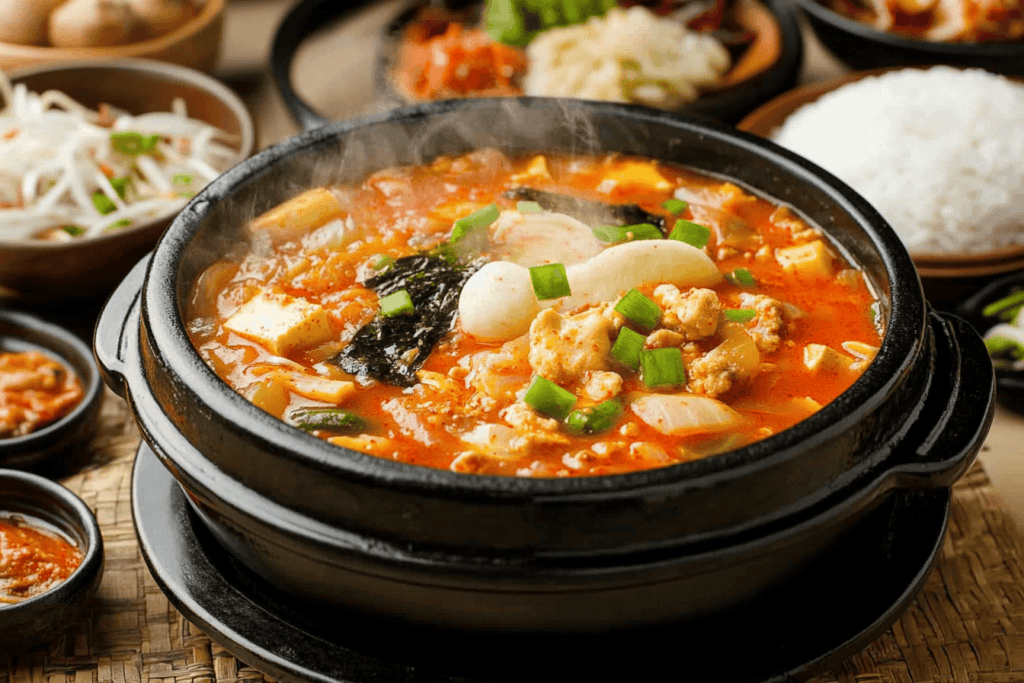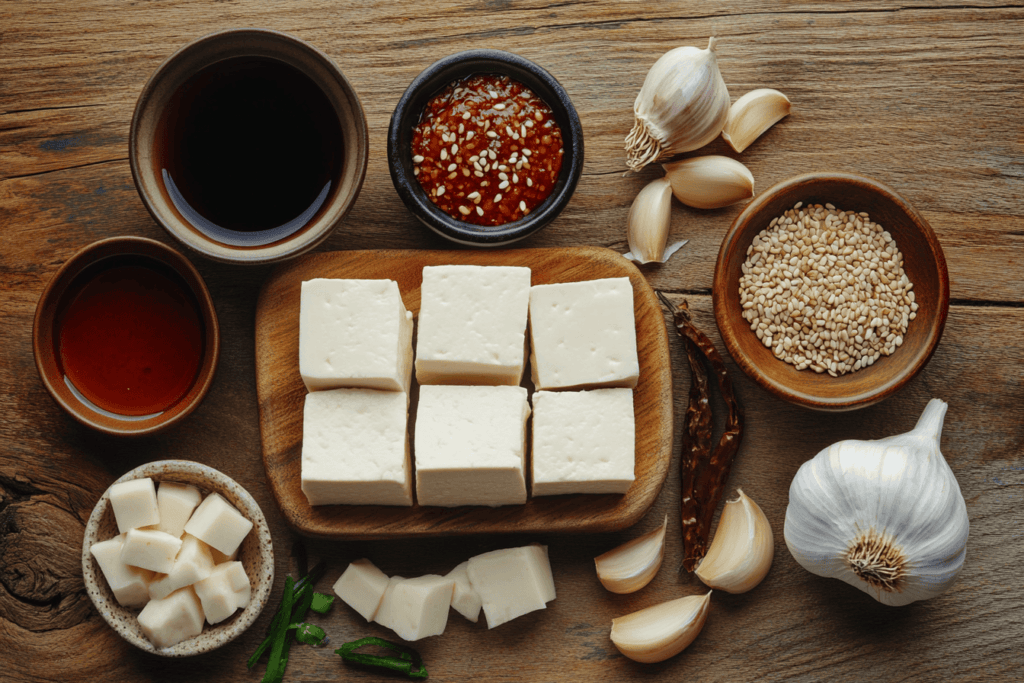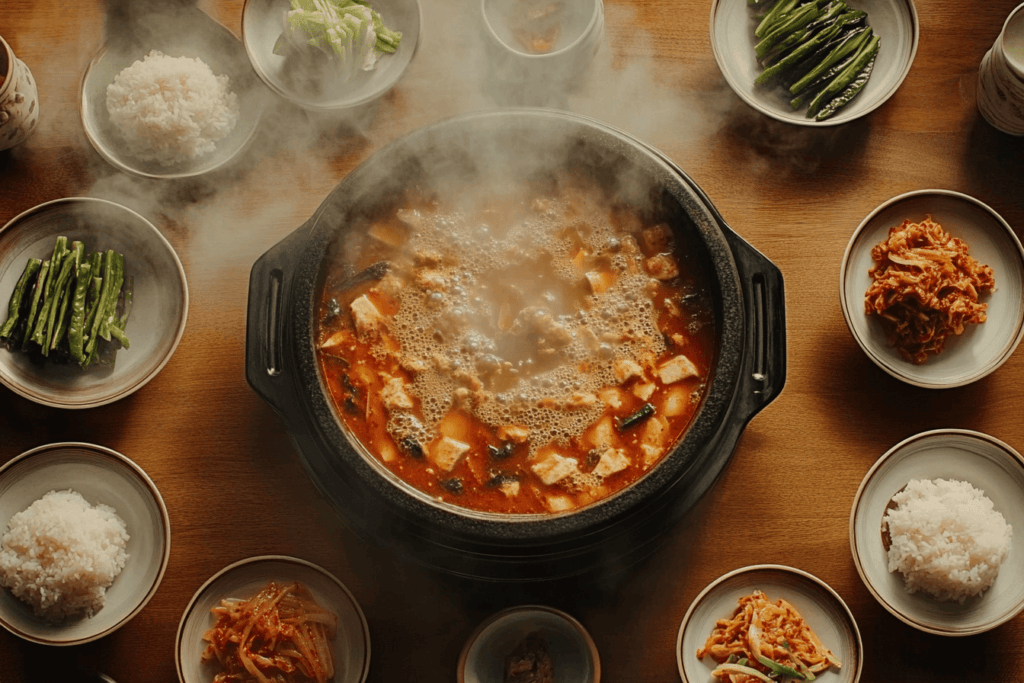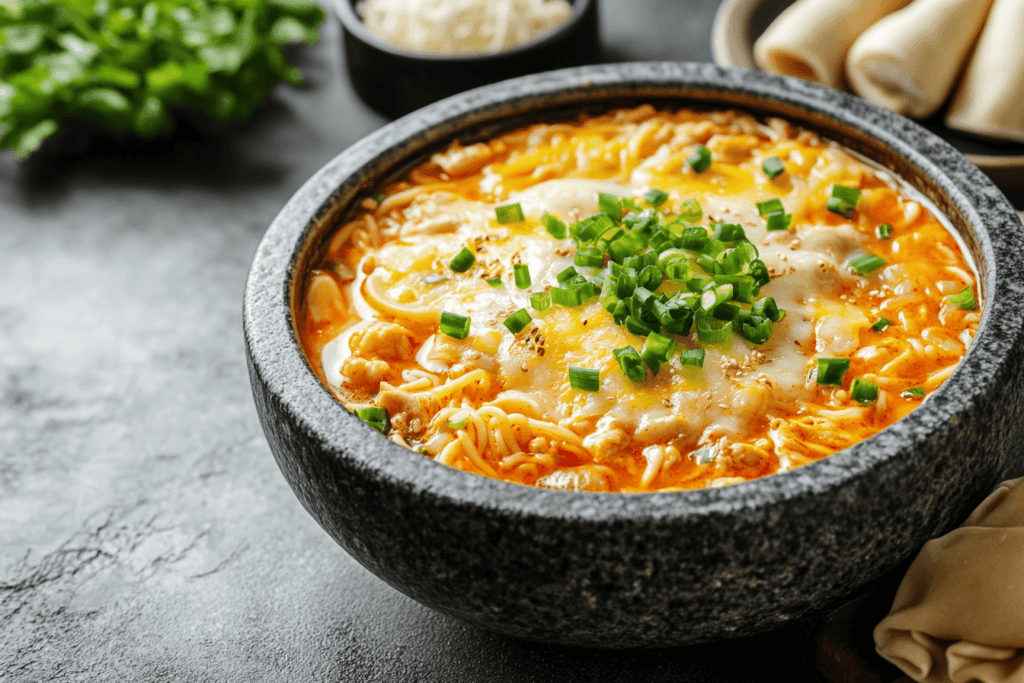
Sundubu-jjigae, often referred to as “soft tofu stew,” is a staple in Korean cuisine celebrated for its rich flavors and comforting warmth. This spicy stew is made with silken tofu, gochugaru (Korean red pepper flakes), and a medley of other ingredients that create a harmonious balance of heat, umami, and heartiness. Often served bubbling hot in a stone pot, Sundubu-jjigae has become a beloved dish not only in Korea but worldwide. Whether enjoyed as a standalone meal or as part of a traditional Korean spread, this dish captures the essence of Korean home cooking.
In this article, we will explore the history, ingredients, preparation methods, and cultural significance of Sundubu-jjigae. Additionally, we will discuss the nutritional benefits and variations that cater to diverse palates. Join us as we dive into the heart of this iconic Korean stew, perfect for warming your soul on a chilly day.
The Origins of Sundubu-jjigae
Sundubu-jjigae is a culinary gem deeply rooted in Korean history and culture. It is more than just a dish; it is a representation of Korean resilience, innovation, and an unwavering commitment to flavorful, nourishing food. To understand Sundubu-jjigae fully, it’s important to explore its historical context and the cultural significance of stews in Korean cuisine.
A Brief History of Korean Stews
Korean stews, known as “jjigae,” have been a cornerstone of Korean dining for centuries. Dating back to the Joseon Dynasty (1392–1897), jjigae were originally created as a way to stretch limited resources by combining ingredients into a single pot of hearty food. Each jjigae often reflected the local ingredients available, from seafood-rich versions along the coastal regions to vegetable-heavy variations in mountainous areas.
The act of sharing a communal pot of stew has long symbolized togetherness and community in Korean culture. This tradition carried forward through centuries, solidifying jjigae as both a daily meal and a celebratory dish for families and gatherings.
Evolution of Sundubu-jjigae in Modern Cuisine
Sundubu-jjigae, specifically, is believed to have originated during Korea’s agrarian period when soybeans were a common staple. The process of creating “tofu” from soybeans was labor-intensive, leading to the byproduct of silken tofu (called “sundubu” or “soft tofu”) becoming a popular, affordable alternative to firmer tofu.
The modern form of Sundubu-jjigae, spiced with gochugaru and featuring ingredients such as clams, pork, or vegetables, gained popularity in the mid-20th century. The dish was particularly celebrated for its affordability, nutritional value, and versatility. During the late 20th century, as Korean food gained global recognition, Sundubu-jjigae followed suit, becoming a favorite comfort food in Korean-American communities and beyond.
Sundubu-jjigae’s Role in Korean-American Communities
A pivotal moment for Sundubu-jjigae’s international fame came in the 1990s when Korean immigrants popularized it in Los Angeles’ Koreatown. Restaurants began serving Sundubu-jjigae in its iconic hot stone bowls, offering variations to appeal to local preferences. The comforting, spicy flavors and the interactive dining experience of cracking a raw egg into the boiling stew made it a memorable dish for newcomers.
Today, Sundubu-jjigae can be found in Korean restaurants worldwide, and its reputation continues to grow. It has become a gateway dish for those new to Korean cuisine and a nostalgic comfort food for Koreans abroad.
Ingredients in Sundubu-jjigae: The Heart of Flavor
Sundubu-jjigae owes its deliciousness to its carefully balanced ingredients, which combine bold spices, delicate textures, and robust umami flavors. Each element plays a crucial role in achieving the dish’s signature taste. Let’s dive into the essential components and discover how they come together to create this culinary masterpiece.
Core Ingredients
The foundation of Sundubu-jjigae lies in its simplicity. While recipes may vary, a few core ingredients are indispensable for making an authentic version of this dish.
Silken Tofu: The Star of the Dish
At the heart of Sundubu-jjigae is silken tofu, also known as “sundubu.” Unlike firm tofu, silken tofu has an ultra-soft texture that melts in your mouth. Made from curdled soy milk that is not pressed, it retains a high water content, giving it its signature silky consistency.
Silken tofu absorbs the flavors of the spicy broth, creating a satisfying contrast between its creamy texture and the bold heat of the stew. It’s also packed with protein, making it a nutritious and filling component of the dish.
Gochugaru and Gochujang: Essential Spices
No Sundubu-jjigae would be complete without the distinct heat and color of gochugaru (Korean red pepper flakes) and gochujang (fermented red chili paste). These ingredients lend the stew its vibrant red hue and its signature spicy-sweet kick.
- Gochugaru: Adds smoky, mildly spicy notes that form the base of the stew’s flavor.
- Gochujang: Enhances the broth with depth and complexity, balancing the heat with a slight sweetness.
The combination of these two spices creates a rich, flavorful broth that is both comforting and invigorating.
Aromatics and Flavor Enhancers
- Garlic: Minced garlic is a key ingredient that brings a pungent, savory aroma to the dish.
- Sesame Oil: Often used as a base for sautéing the aromatics, sesame oil contributes a nutty richness to the broth.
- Soy Sauce: Adds salty umami, complementing the other bold flavors in the stew.

Optional Ingredients for Customization
While the core ingredients form the foundation of Sundubu-jjigae, the dish is incredibly versatile, allowing for endless variations.
Seafood Variants
Seafood Sundubu-jjigae is a popular version of the dish, featuring ingredients such as clams, shrimp, mussels, or squid. These add a briny, oceanic flavor that pairs beautifully with the spicy broth.
- Clams: Often used to create a light and flavorful seafood broth.
- Shrimp and Mussels: Contribute a slightly sweet, succulent taste to the dish.
Vegetarian and Vegan Alternatives
For vegetarians or those seeking a plant-based option, Sundubu-jjigae can easily be adapted by substituting the meat or seafood with vegetables and plant-based proteins.
- Mushrooms: Shiitake or enoki mushrooms are great choices for adding a meaty texture and umami flavor.
- Vegetable Broth: Replacing seafood or meat-based broth with a rich vegetable stock ensures a hearty, flavorful base.
Customizing Sundubu-jjigae to Your Taste
One of the most appealing aspects of Sundubu-jjigae is how customizable it is. Whether you prefer it fiery hot, mild and savory, or loaded with seafood and vegetables, there’s a version of this dish for everyone.
How to Make Sundubu-jjigae at Home
Making Sundubu-jjigae at home is a delightful experience that allows you to customize the dish to your liking while savoring the rich, authentic flavors of Korean cuisine. With a few staple ingredients and some simple techniques, you can create a bubbling pot of Sundubu-jjigae that rivals any restaurant’s offering.
Preparing the Base
The base of Sundubu-jjigae sets the tone for its flavor. Typically, the stew begins with a combination of savory aromatics, spicy seasonings, and a flavorful broth.
Key Ingredients for the Base
- Aromatics: Garlic, onions, and green onions are sautéed in sesame oil to infuse the dish with a nutty aroma.
- Seasonings: Gochugaru (red pepper flakes), gochujang (chili paste), and soy sauce form the backbone of the stew’s spicy and savory profile.
- Broth: You can use anchovy broth, beef broth, or a vegetable-based stock depending on your preference. Anchovy broth is a traditional choice, offering depth and umami.
Step-by-Step Instructions
Follow these steps to prepare a delicious pot of Sundubu-jjigae:
Sauté the Aromatics
- Heat 1–2 tablespoons of sesame oil in a deep pot or stone bowl.
- Add minced garlic, chopped onions, and the white parts of green onions. Sauté until fragrant and lightly golden.
The Seasonings
- Stir in 1–2 tablespoons of gochugaru and 1 tablespoon of gochujang.
- Mix well with the aromatics until the spices are evenly distributed, releasing a deep red color and spicy aroma.
The Broth
- Pour in about 2–3 cups of broth (anchovy, beef, or vegetable stock).
- Stir the mixture and bring it to a boil. This will meld the flavors of the seasonings into the broth.
The Tofu and Other Ingredients
- Gently add the silken tofu in large spoonfuls. Avoid breaking it up too much to preserve its creamy texture.
- Incorporate your choice of protein or vegetables, such as clams, shrimp, pork, mushrooms, or zucchini.
Simmer and Serve
- Allow the stew to simmer for 5–10 minutes until the proteins are cooked through and the flavors have melded.
- Just before serving, crack a raw egg into the bubbling stew and garnish with the green parts of the green onion.
- Serve the Sundubu-jjigae hot with a side of steamed rice.
Tips for Achieving Authentic Flavors
To make your Sundubu-jjigae truly authentic, consider these tips:
- Use Korean Ingredients: Opt for high-quality Korean gochugaru and gochujang for the best flavor.
- Fresh Tofu: Use freshly made silken tofu whenever possible for the creamiest texture.
- Adjust Spice Levels: Customize the spice to your liking by adjusting the amount of gochugaru and gochujang.
- Serve in Stoneware: If you have a Korean stone pot (ttukbaegi), use it to serve the dish. It retains heat and keeps the stew bubbling hot for a more authentic dining experience.
Sundubu-jjigae in Korean Dining Culture
Sundubu-jjigae is more than just a dish in Korean cuisine—it is a cultural icon and a beloved comfort food that reflects the communal spirit and culinary traditions of Korea. Its presence in Korean dining is as much about its flavors as it is about the experience of enjoying it with others.
Traditional Serving Styles
In Korea, Sundubu-jjigae is often served in a traditional ttukbaegi (stone pot), which is designed to retain heat and keep the stew boiling hot even after it is brought to the table. This not only enhances the dining experience but also ensures that the dish remains warm throughout the meal.
- Rice Pairing: A steaming bowl of short-grain white rice is served alongside Sundubu-jjigae, allowing diners to balance the spicy flavors with mild, fluffy rice. Some even scoop a bit of rice into the bubbling stew for a heartier bite.
- Banchan (Side Dishes): Like most Korean meals, Sundubu-jjigae is accompanied by an array of side dishes, including kimchi, seasoned spinach (sigeumchi-namul), and pickled radish (danmuji). These banchan complement the stew with additional textures and flavors.
The interactive nature of the meal, including cracking a raw egg into the stew or mixing in rice, makes eating Sundubu-jjigae a sensory experience that engages sight, smell, and taste.

Role in Korean Comfort Food
Sundubu-jjigae holds a special place in the hearts of Koreans as a quintessential comfort food. Its warm, spicy flavors and nourishing ingredients make it an ideal choice for cold weather or when someone is feeling under the weather.
- Emotional Warmth: The dish is often associated with home-cooked meals and family gatherings, evoking a sense of nostalgia for many Koreans.
- Hearty and Versatile: Its rich, hearty nature makes it a satisfying meal that can be tailored to individual tastes, whether someone craves seafood, pork, or a vegetarian version.
- Shared Experience: In traditional Korean culture, meals are a communal activity. The bubbling pot of Sundubu-jjigae placed at the center of the table encourages sharing and connection among family and friends.
Global Popularity
While Sundubu-jjigae has deep roots in Korean culture, it has also found a global fanbase, particularly in countries with significant Korean immigrant communities like the United States, Canada, and Australia.
- Koreatown Restaurants: Cities like Los Angeles and New York have become hubs for authentic Korean food, and Sundubu-jjigae is a staple menu item in many Korean restaurants.
- Fusion Variations: The dish has inspired creative twists in international kitchens, including less spicy versions for milder palates and additions like cheese or ramen noodles for a fusion experience.
Sundubu-jjigae’s rise in global popularity highlights the universal appeal of its bold flavors and comforting qualities, making it a favorite for both Korean cuisine enthusiasts and those discovering it for the first time.
Health Benefits of Sundubu-jjigae
Sundubu-jjigae is not only tasty but also packed with nutrients. With healthy ingredients like silken tofu, vegetables, and spices, it offers both comfort and health benefits in every bite.
Nutritional Value of Silken Tofu
Silken tofu is the main ingredient in Sundubu-jjigae and is both light and healthy.
- High in Protein: It is a great source of protein, especially for vegetarians.
- Rich in Calcium and Iron: These minerals help keep bones strong and support the blood’s ability to carry oxygen.
- Low in Calories: Silken tofu is filling but doesn’t add many calories, making it perfect for a satisfying meal.
Digestive and Immunity Boosting Ingredients
The other ingredients in Sundubu-jjigae also contribute to its health benefits:
- Gochugaru and Gochujang: These chili-based ingredients are rich in capsaicin, a compound known to boost metabolism and improve digestion. Capsaicin also has anti-inflammatory properties, which can enhance immunity.
- Garlic: A staple in the dish, garlic is known for its antibacterial and antiviral properties, helping to strengthen the immune system.
- Seafood: If included, seafood adds omega-3 fatty acids, which promote heart and brain health.
- Vegetables: Ingredients like mushrooms, zucchini, and green onions provide fiber, vitamins, and antioxidants that support overall health.
A Balanced, Customizable Meal
One of the greatest advantages of Sundubu-jjigae is its adaptability. Whether you add seafood, pork, or keep it vegetarian, you can adjust the dish to meet specific dietary needs. For those avoiding gluten, using tamari instead of soy sauce ensures a gluten-free version.

FAQs About Sundubu-jjigae
To help you enjoy Sundubu-jjigae to its fullest, here are answers to some commonly asked questions:
What makes Sundubu-jjigae different from other Korean stews?
Sundubu-jjigae is unique due to its use of silken tofu, which creates a soft and creamy texture that is distinct from firmer tofu used in other Korean stews. Additionally, its vibrant red broth, flavored with gochugaru and gochujang, gives it a spicier, more robust taste. For another creamy and rich meal idea, check out the Ultimate Branzino Recipe.
Is Sundubu-jjigae spicy?
Yes, Sundubu-jjigae is traditionally spicy, but the level of heat can be adjusted to suit individual preferences. You can reduce the amount of gochugaru and gochujang for a milder version or add more for an extra kick. If you love spice, consider exploring the Mexican Chicken Soup Recipe for another flavorful dish.
Can you make Sundubu-jjigae without tofu?
Silken tofu is a defining feature of Sundubu-jjigae, but if you cannot use tofu, you can substitute it with soft scrambled eggs or mushrooms for a similar creamy texture. Keep in mind that this variation will differ from the traditional recipe. For creative ways to substitute ingredients, you might enjoy reading about the Best Ninja Creami Recipes.
What is the best way to serve Sundubu-jjigae?
Sundubu-jjigae is best served piping hot in a stone pot, accompanied by steamed white rice and a selection of banchan (side dishes). Cracking a raw egg into the bubbling stew just before eating adds extra richness to the dish. You might also want to explore how to pair dishes by checking the What to Eat with Alice Springs Chicken guide.
Is Sundubu-jjigae gluten-free?
While the dish can be made gluten-free, it depends on the ingredients used. Opt for gluten-free gochujang and soy sauce (or tamari) to ensure a completely gluten-free version of Sundubu-jjigae. For another gluten-free option, try the Zuppa Toscana recipe.
Can I freeze leftovers?
Yes, Sundubu-jjigae can be frozen, but it’s best to do so without the tofu, as it may change texture when thawed. Freeze the broth and other ingredients, then add fresh silken tofu when reheating for the best results. If freezing meals is your go-to, see this article about Can You Freeze Chicken and Dressing for more tips.
Conclusion: The Enduring Appeal of Sundubu-jjigae
Sundubu-jjigae is a dish that embodies the heart and soul of Korean cuisine. Its rich flavors, comforting warmth, and versatility make it a beloved meal for all occasions. Whether you’re savoring a bubbling pot at a Korean restaurant or preparing it at home, Sundubu-jjigae offers a sensory experience that leaves a lasting impression.
With its growing global popularity, this spicy tofu stew continues to bring people together, one comforting bowl at a time
